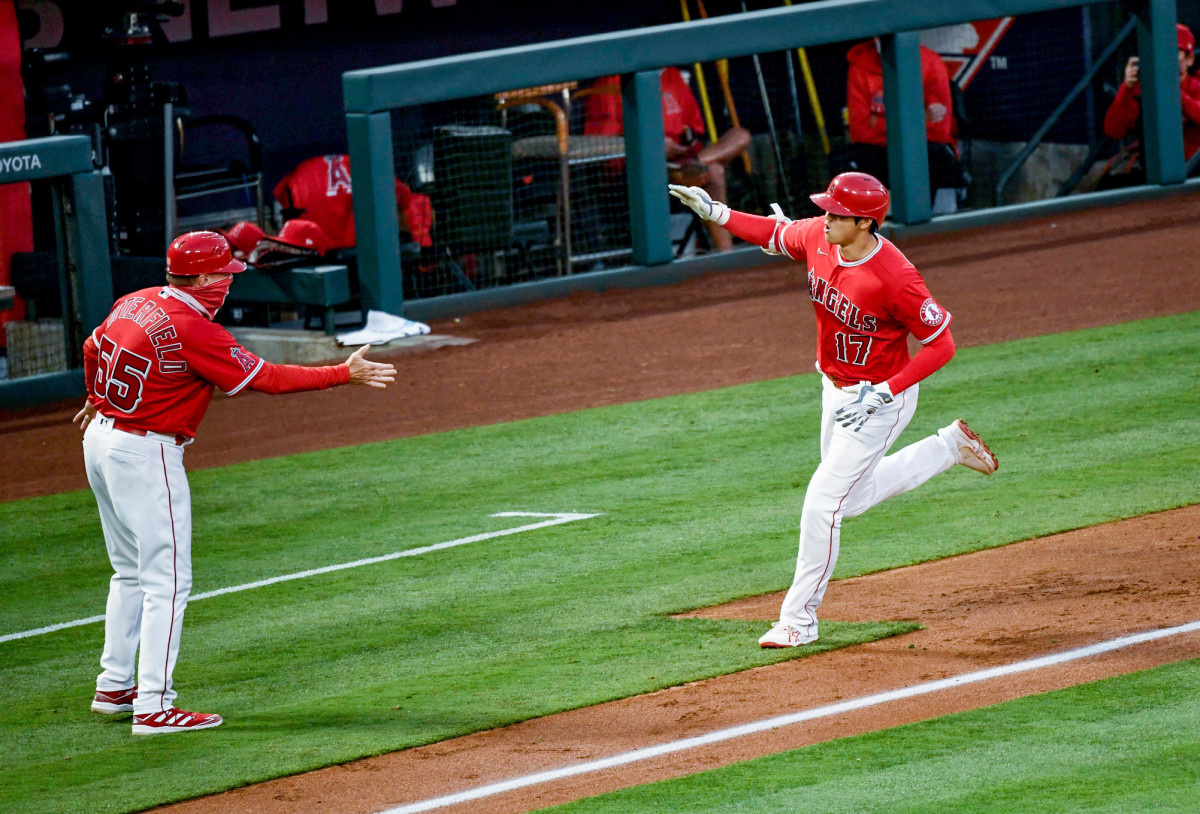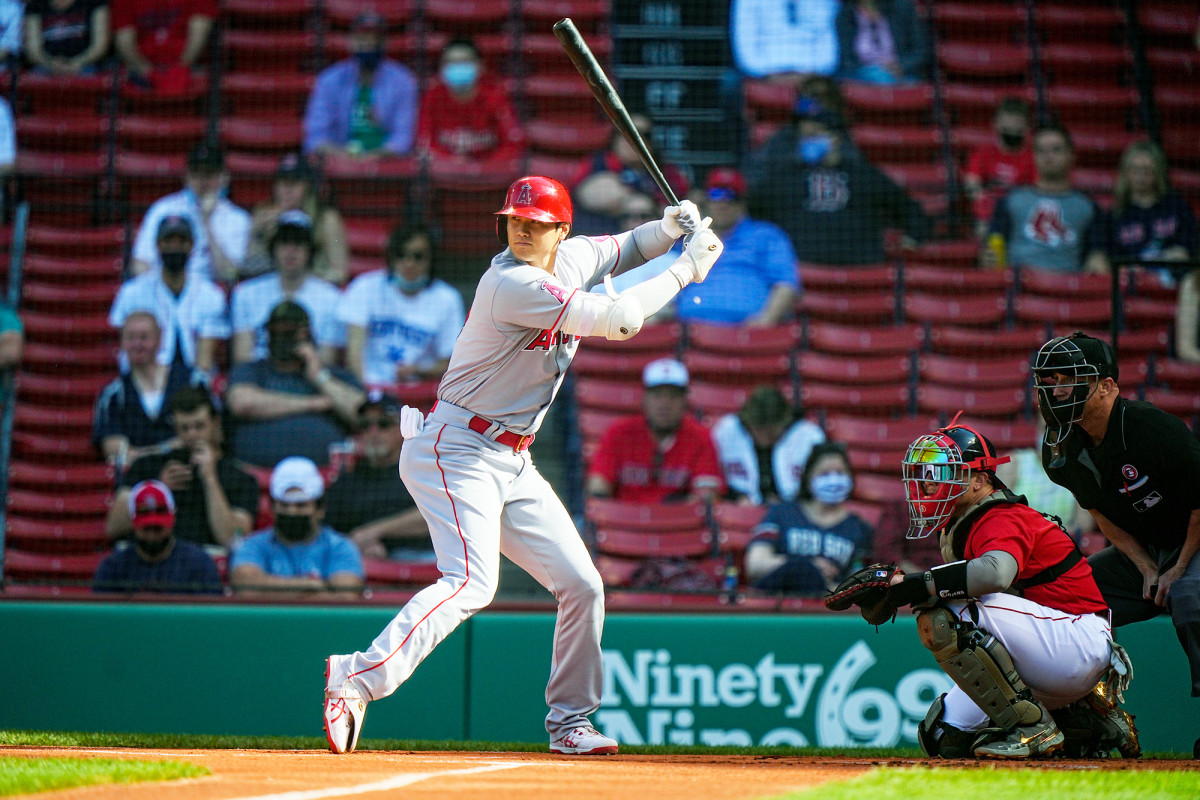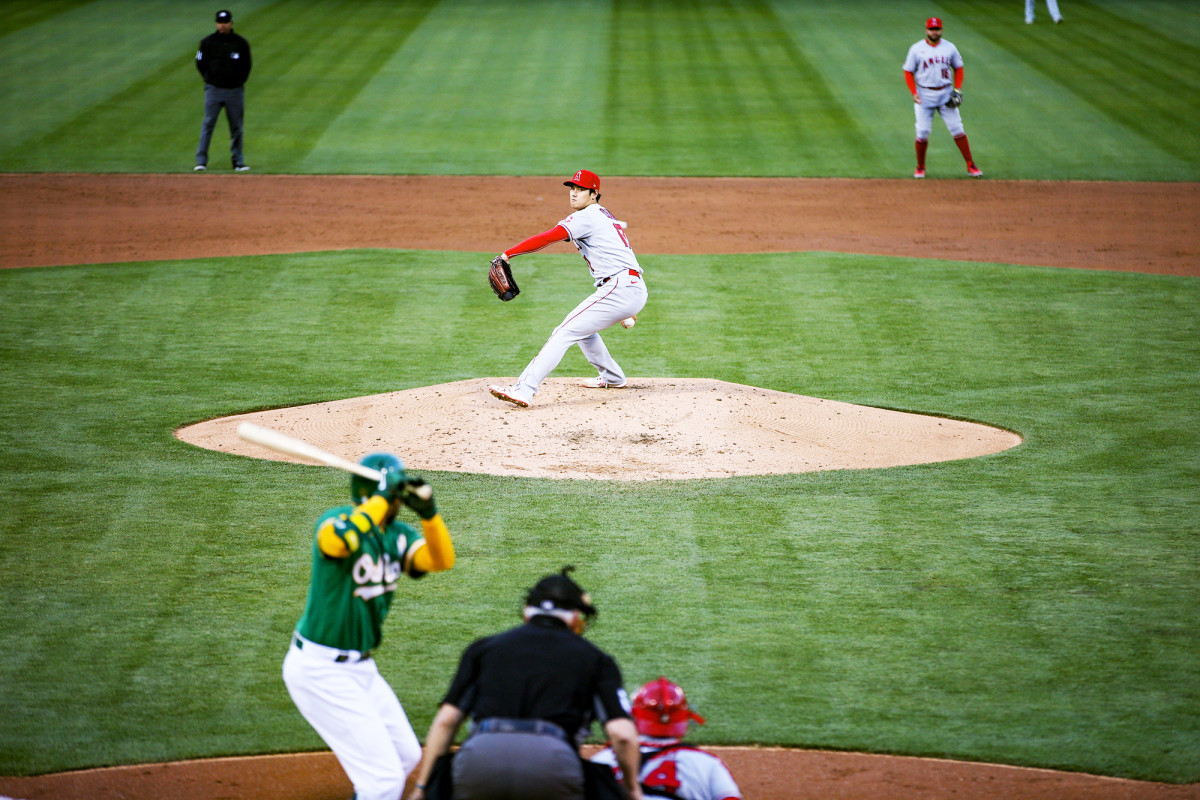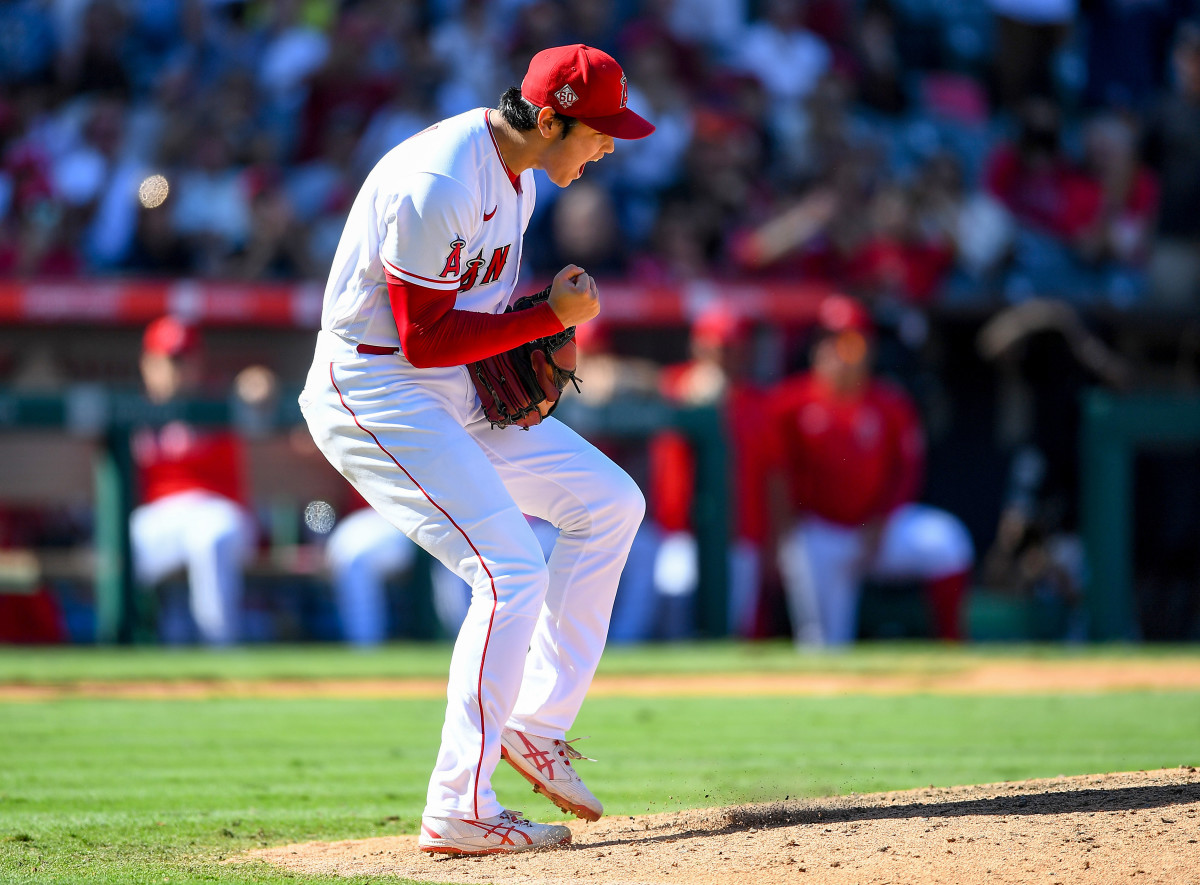We Haven’t Seen the Best of Angels Superstar Shohei Ohtani
Every morning last month, just after dawn broke over Tempe, Ariz., a half dozen or so media members from Japan would hike partway up the incline of a small mountain overlooking the players’ parking lot at the Angels’ spring training complex. They set up their video cameras and waited as patiently as bird watchers. The rara avis they sought to glimpse was Shohei Ohtani, the most incredible baseball player on the planet.
Eventually, a familiar SUV would pull into the lot below the lookouts. As soon as Ohtani and his friend and interpreter, Ippei Mizuhara, exited the vehicle, video cameras would roll. The walk from his SUV to the door of the clubhouse covered no more than 100 or so feet. As soon as he slipped behind the door, the bird watchers packed up and headed down the incline. That was it. Every day. It is hard to imagine a more pedestrian scene, but because it was Ohtani, it needed to be covered.
Welcome to a new phase in the career of Ohtani. It officially begins Thursday night when Ohtani pitches and bats leadoff for the Angels against Houston on Opening Day at Angel Stadium. The extraordinary is now expected.

One year ago, Ohtani was a curiosity coming off a season in which he hit .190 and pitched 1 2/3 innings after not pitching at all in 2019. This time he is the most amazing player in baseball—probably even in the game’s history.
Ohtani slugged .592, second only in the AL to Vladimir Guerrero Jr., hit 46 home runs, behind only Guerrero and Salvador Perez, and won the MVP while also going 9–2 with a 3.18 ERA in 23 starts with more strikeouts than both Clayton Kershaw and Jacob deGrom.
Babe Ruth, the only applicable comparison, never came close to Ohtani’s combination of 46 homers and 23 starts. The best the Babe did was 29 homers and 15 starts in 1919. And Ruth never kept such plates spinning for as long as Ohtani did last year. Ruth was a full-time two-way player for only 106 team games in ’18 and 82 games in ’19 before he yielded to the physical grind.
After Ohtani redefined the realm of what is possible in MLB last season, could he be even better this season?
“My thought is that I think it’s possible,” says Angels manager Joe Maddon. “Am I looking for more? Not necessarily. If we get a repeat performance, I’ll take that. One hundred percent, I’ll take that. Knowing the individual, he’s expecting more. That’s what I see. Am I looking for it? No.
“He has such high expectations.”
Watching Ohtani prepare for this season is a window into why he is such an extraordinary player. His meticulousness is even more impressive than his physical skills. The Angels leave Ohtani on his own program because he is one of a kind.

For instance, while the Angels run through defensive team drills, complete with pitchers, Ohtani isn’t even on the practice field. He is working out at an outdoor gym next to the clubhouse, pulling on bands in all directions, walking with a kettlebell above his head with his arm bent at 90 degrees, mimicking a throwing motion with weighted gloves on each hand, and running through other assorted maneuvers that add strength but not bulk to his Michael Phelps–like long, hyperflexible body.
One day he skipped a scheduled spring training start to throw an intense game-like bullpen session in which he simulated at bats throwing to catcher Max Stassi. He videotapes every one of his throwing sessions from a side angle. He alone decides when, what and for how long he throws.
“He knows what he’s doing,” Maddon says. “Am I going to monitor him and say, ‘Come do this?’ Hell no. He knows exactly what he’s doing. The guys [on the team] know that.”
Says Stassi, “He’s right where he needs to be. He’s the kind of guy who can ramp it up and throw a hundred and be fine the next day. He’s just ... different.”
Ohtani could put up a better offensive season this year if Mike Trout and Anthony Rendon stay healthy. Last season Ohtani played only 17 games with those two in the same lineup. With Phil Gosselin and David Fletcher providing most of the protection behind him late last season, Ohtani hit .217 in his final 60 games.
This year Maddon will bat Ohtani leadoff, followed by Trout and Rendon. That puts opposing managers in a box created by the three-batter minimum rule. If a manager brings in a lefty to face Ohtani with no outs (he had a slightly higher OPS against lefties last year), then the lefty must deal with Trout and Rendon, right-handed hitters. Ohtani also may get a few more at bats because of the DH in NL parks and because of the so-called “Ohtani Rule,” which allows him to remain in the game as a DH after he has been removed from pitching.
Ohtani is such a tremendous offensive player that his suite last season of 46 homers, 26 stolen bases and eight triples never had been accomplished in baseball history. He hit more balls 430 feet or more than any hitter in the majors (16).

And yet … that same premier slugger also throws the hardest pitch to hit in baseball since he stepped on a major league field in 2018. Ohtani has thrown 575 split-finger fastballs in his career. No one has ever hit one for a home run. Only 14 times did somebody get a hit off one of those 575 splitters.
If you counted all the pitches thrown at least 500 times by all the pitchers over the past four years you would get a collection of 1,406 unique pitches. The lowest batting average among those 1,406 pitches is the .075 batting average against the Ohtani splitter. More than his home-run power and more than his fastball, which averages 95.6 mph and 11 times last season reached 100, the splitter is what most separates Ohtani from his peers. It is that nasty.
I ask pitching coach Matt Wise what makes the Ohtani splitter so special. He takes a deep breath.
“I mean, there was a start in Detroit last year,” Wise says. “His slowest fastball was 89 [mph]—because he throttles the fastball—and his hardest fastball was [99]. His hardest split was 90. I don’t remember how slow his slowest split was [85].
“It is a strike until it’s a couple of feet in front of the plate. He did such a good job of getting ahead in counts last year that all of a sudden he goes to that [split], and it’s a swing and miss. People try to look for it, but it has such late depth that it often results in a swing and miss.”
Major league hitters batted .038 against Ohtani’s splitter when he was ahead of the count, with just three hits in 78 at bats.
Ohtani almost always throws his splitter over the heart of the plate for the first 58 feet of its journey toward home, only to have it dive below the batter’s swing path. Almost all its deception is in its vertical path, which is why his catchers set up in the middle of the plate for it. But ever so rarely his splitter may cut or fade. Is Ohtani intentionally imparting horizontal movement sometimes?
“He might. I’m not positive that he does,” Wise says. “He has such a feel for what he does. Joe [Maddon] told me early in the year, ‘Don’t try to figure him out.’ There is a method to what he does with everything. Everything. So he might do that a little bit at times.”
The splitter is the essence of Ohtani. As much as we marvel at his power, his control of the baseball, his mind and the situation are where you find the true genius of Ohtani. The splitter is at the nexus of those powers.
“First of all, he throws it hard,” says Angels catcher Kurt Suzuki. “Sometimes it’s like 91. He can get it up there. He throws his fastball a hundred and then he shows the exact same arm action on a splitter at 90. It’s still hard, but it’s not a hundred, and it just dives down.
“Some guys with a split, they can cut it like a slider, and some can make it run. I personally think Shohei can do whatever he wants with it. He knows what he’s doing. Sometimes he can make it cut. He knows what to do with it and why. He’s very sharp. He reads hitters and their swings so well.”

Splitters in general are devastating pitches because they essentially are changeups with late, less predictable movement. The average major league splitter spins 22% less than a changeup (1,365 rpms vs. 1,750). The less a ball spins the more it is susceptible to the vagaries of air pressure passing over and under it.
As Suzuki says, “If somebody throws a split, it’s almost always, ‘Hey, his split is good.’ It’s always their out pitch.”
Says Oakland catcher Sean Murphy, “The thing with the splitter is it’s the same arm speed as a fastball. The speed difference is like a changeup, but it’s also unpredictable with the way it moves. Some will tumble; some will dive.
“Obviously, Ohtani is throwing so hard out there that the split finger just blends in with his fastball and you have to make a quick decision on it. And his split moves just a ton. As far as his movement, arm speed and velocity, it’s special.”
Splitters also are so hard to hit because hitters don’t see them often. Over the past 14 seasons, the rate of splitters has remained in a narrow range of between 1.4% and 1.8% of all pitches. Last season, for instance, Francisco Lindor of the Mets saw just 17 splitters all year, including just one in the team’s first 70 games. (He went 0-for-5 on the season vs. the splitters.)
Batters hit .183 against splitters last season, but only 6% of all pitchers threw one. Why don’t more pitchers throw a split?
“It’s difficult on your elbow, from what I’ve heard,” Murphy says. “A lot of guys, if they can develop a changeup, keep the changeup. Splitters happen sometimes when somebody goes, ‘Hey, the changeup’s not working. Let’s try a split.’ It’s a complete downward pitch because of the unpredictability of it.”

Ohtani throws his splitter 18% of the time, which raises a question: If it’s the toughest pitch to hit in baseball, why doesn’t he throw it more often?
“Because everything else he throws is really good, too,” Wise says. “He did have a start last year where he threw 55 in a game. He did alter the shape on that day, to just move the ball a little bit.
“But he can touch 101, he commands the slider, he can slip a curveball in there. Everything he does … he has a feel for the baseball better than anyone I’ve ever seen.”
I ask Suzuki the same question about why Ohtani doesn’t throw the best pitch in baseball more often.
“With him, he’s very strategic with how he uses his pitches,” the catcher says. “He knows what’s working. He knows what’s good. And he can mix it up at any time.
“Sometimes he wants to not throw that pitch until he has two strikes. Some days he wants to throw it early. Sometimes he wants to throw his cutter more, or his slider.”
Last season Maddon took off all the governors on Ohtani and simply let him be a ballplayer. Rather than the front office dictating his workload and schedule, as had been done, Maddon sat down with Ohtani before the season and empowered the player to create his own program. “You control the joystick,” Maddon told him in what turned out to be the aptest analogy. Ohtani put up video game numbers.
He did not appear to tire. Ohtani, for instance, averaged over 97 mph with his fastball in two starts last season: his first and his last. There is no need for the Angels to take the joystick away from him.
“There is no blueprint,” Maddon says. “He’s not like anybody else, so why should he have the same program as everybody else? It’s like an NFL punter or placekicker. Do you want them to be on the same program as the rest of the team?”
Thursday night, Ohtani will throw the first pitch of the Angels’ season and take their first at bat. Nobody can know what will happen next because that is how Ohtani plays baseball. He pitches not with a script but with feel. Every start is a creation of time and place, like brushstrokes of paint across a canvas.
“We just go the first inning with a scouting report,” Suzuki says. “And then he’ll come in the dugout and tell us what feels good. So we just go, ‘O.K., let’s go.’ So he changes it every game.
“It’s not like a scouting report a team goes over and goes into a game saying, ‘He’s going to do this.’ He’ll come in after the first inning and say, ‘We’re not going to do this today, we’re going to do this.’ And we go, ‘O.K., let’s do it.’
“He’s fun to catch. But sometimes his split is moving so much that it’s not fun to catch. It’s filthy.”

It was the second-century Roman poet Juvenal who coined the term rara avis. Translated from Latin in his collection of poems known as the Satires, he wrote, “A rare bird on this earth, like nothing so much as a black swan.” The black swan was thought to be an impossibility, and thus a challenge to presumed logic. More than 1,500 years later, in 1697, Dutch explorers in Western Australia became the first Europeans to see such a creature. The black swan became the symbol of a true outlier.
Ohtani is that outlier, and the wonder every time we see him, with his unmatched combination of skill and savvy, does not fade. He has redefined what is possible. From the mountains to the ballparks, we wait and watch to see what baseball’s rara avis will do next.
More MLB Coverage:
• Remember Mike Trout? MLB’s Best Player Is Back With More to Prove
• MLB Predictions for MVP, Cy Young and Rookie of the Year Awards
• MLB Regular-Season, Playoff and World Series Predictions
• One Big Question for Every American League Team
• One Big Question for Every National League Team
